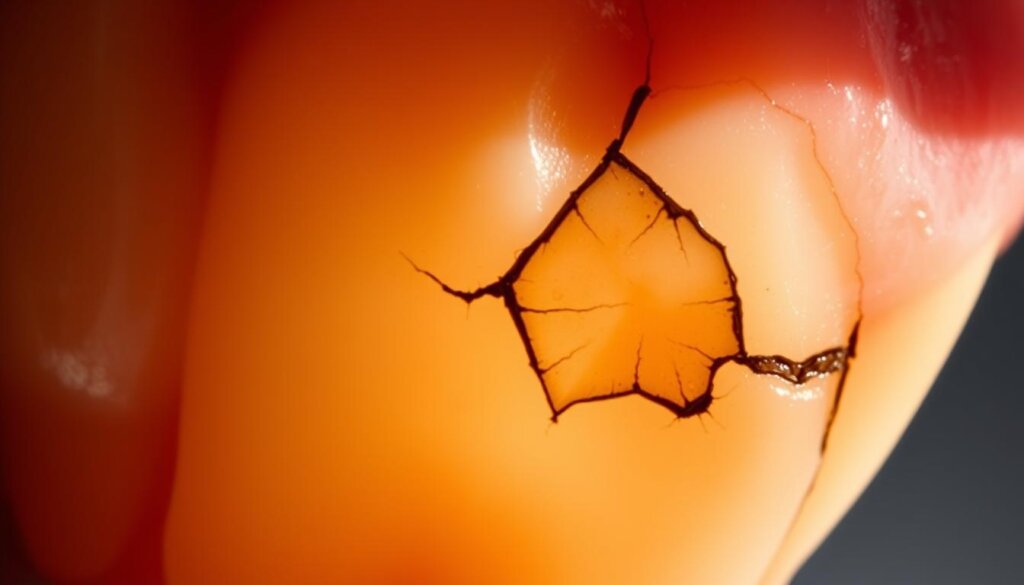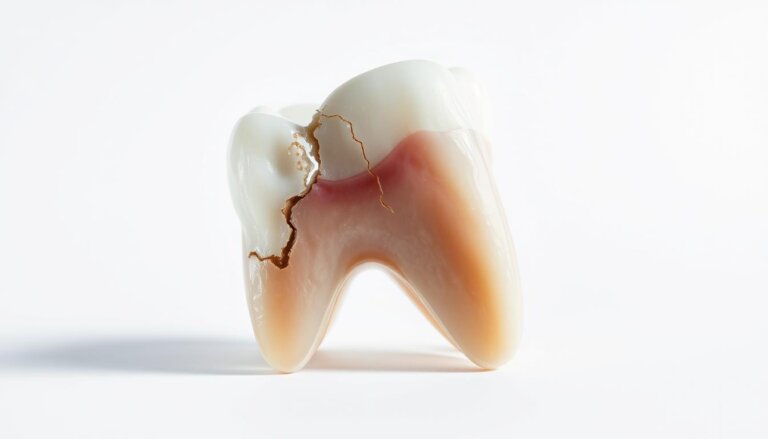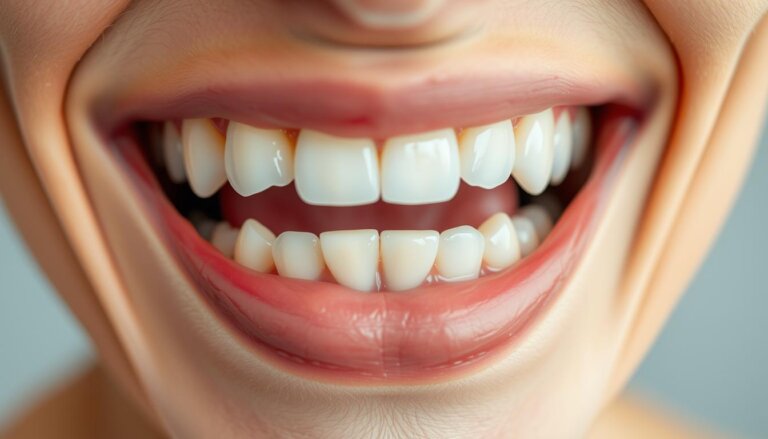What are the Signs that I Have a Cracked or Fractured Tooth?
About one in four adults will face tooth cracks in their lifetime, says the American Dental Association. These breaks can hide for months. Many wonder, “What are the signs that I have a cracked or fractured tooth?”
Cracks can come from accidents or grinding over time. Finding them early is key to keeping teeth healthy. This info shows why quick dental checks are important for a strong, pain-free smile.
Key Takeaways
- Cracked teeth often stay undetected until pain escalates.
- Early signs may include sharp aches or sensitivity.
- Grinding habits increase the risk of fracture.
- Timely dental evaluation aids in preventing complications.
- Knowledge of warning signals supports proactive dental care.
Understanding Cracked and Fractured Teeth
Dental cracks can happen in different ways. They can be caused by sudden stress or gradual wear. People often feel mild pain that gets worse if the crack gets deeper or spreads.
Definition of Cracked Tooth
A cracked tooth is when the enamel is partially damaged. It might happen when you bite hard or clench your teeth. Spotting these symptoms early can help protect your tooth and ease pain.
Definition of Fractured Tooth
Fractures are more serious, breaking the tooth into parts. They can damage the dentin or even reach the pulp. Dentists can see these breaks during exams or with imaging. Quick action is key to treating the problem and stopping further damage.
Common Causes of Cracked Teeth
Dental enamel faces daily pressures that can cause sudden cracks. Small stress lines can grow into bigger problems over time. Finding tooth fracture signs early can help keep your teeth healthy.
These fractures come from many factors that weaken teeth. Each case has its own challenges. They may need a dentist’s help for the right care.
Teeth Grinding
Constant clenching or grinding puts a lot of force on teeth. This habit, called bruxism, can start small cracks. These cracks can grow into bigger lines over time. Grinding teeth a lot can make tooth fractures more likely.
Physical Impact or Injury
Strenuous activities like contact sports put sudden force on teeth. Accidents or sudden blows can chip enamel. This can lead to deep fractures if not treated. Wearing protective gear can help lower the risk of injury.
Aging and Wear
As we age, our teeth naturally wear down. Enamel gets thinner, making older people more likely to fracture teeth. Sometimes, even a little pressure can cause a fracture.
Initial Signs of a Cracked Tooth
People might notice small signs of tooth damage early on. These signs can come and go, making it hard to know what’s happening. Dentists say it’s important to catch these signs early to avoid bigger problems.
Those who feel these early warnings often see a dentist when the pain gets worse. Cracked tooth pain often comes and goes, which can mean the tooth is not as strong as it should be.
Sensitivity to Temperature
One early sign is feeling sharp pain when eating hot or cold things. Drinking coffee or ice water can cause sudden pain. This happens because the tooth’s outer layer is damaged, leaving it exposed.
Using desensitizing toothpaste or a soft-bristled toothbrush can help with mild pain.
Pain During Chewing
Cracked tooth pain can also happen when you bite down on hard foods. Foods like nuts or pretzels can put too much pressure on a weak tooth. You might feel a sharp pain that goes away after you stop biting.
Avoiding hard snacks can help prevent the crack from getting worse.
Some things that can trigger this pain include:
- Biting on hard foods or objects
- Exposure to extreme temperature changes
- Stress from uneven biting forces
| Indicator | Observations |
|---|---|
| Temperature Sensitivity | Short bursts of pain on contact with heat or cold |
| Chewing Discomfort | Quick pangs when biting into firm items |
Advanced Symptoms of a Fractured Tooth
Small hairline cracks might not show up until pain strikes or changes in the tooth happen. Knowing how to spot a cracked tooth early is key to keeping your teeth healthy. It helps tell apart minor pain from serious damage.
As problems get worse, you might feel constant pain, swollen gums, or see small pieces breaking off. Acting fast can stop things from getting worse.
Persistent Toothache
Severe pain that won’t go away could mean the crack has reached deeper parts. This pain can last for hours or come and go, making everyday tasks hard.
Swelling in the Gums
Swollen or sore gums might mean an infection is brewing. Bacteria can sneak in through the crack and cause inflammation.
Visible Cracks or Chips
Some cracks show up as small lines or chips on the tooth. Seeing any changes means you should see a dentist to avoid bigger problems.
| Sign | Possible Issue |
|---|---|
| Long-Lasting Aches | Pulp Irritation |
| Gum Redness | Bacterial Invasion |
| Chipped Edges | Exposed Tooth Layers |
Pain Characteristics of a Cracked Tooth
Cracked teeth can cause unpredictable pain. These pains are early signs that you might have a broken tooth. They can be sharp and short, or a dull ache that lasts all day.
Spotting these signs is key to getting the right treatment. It helps doctors figure out what’s wrong and how to fix it.
Intermittent vs. Constant Pain
Some people feel sharp pain when they bite down or drink cold drinks. This is often a sign of a small crack that bothers the nerves. But, if the pain doesn’t stop, it could mean the crack is deeper and hurting the inside of the tooth.
Noticing these differences helps doctors make better diagnoses. This can lead to more effective treatments.
Location-Specific Discomfort
Knowing where the pain is can help figure out if it’s from a crack or something else. Some people feel pain in one spot when they chew. This can be a sign of a crack that needs to be checked by a dentist.
Spotting these patterns is important. It helps dentists find the problem and fix it before it gets worse.
How a Cracked Tooth Differs from Other Dental Issues
Cracked enamel is different from other dental problems. It can cause sharp pain when biting, but the pain might go away quickly. This makes it hard for both patients and dentists to understand.
Comparing with Cavities
The American Dental Association says cavities slowly wear away the enamel. They cause pain when eating sugary foods. But, a cracked tooth’s pain comes and goes, showing it’s a deeper problem.
Distinguishing from Gum Disease
Gum disease makes gums inflamed, bleed, or hurt. You might see red gums or feel pain all the time. But, a cracked tooth usually hurts in one spot, not all over.
When to Visit the Dentist
Seeing a dentist early can stop a small crack from getting worse. A quick check-up can save your tooth and prevent infection. This way, you can avoid pain and more serious problems.
Importance of Timely Diagnosis
Finding dental issues early is key to avoiding big problems. Quick action helps prevent serious damage that could harm your teeth. Dentists use advanced tools to spot even the smallest cracks.
Signs That Warrant Immediate Attention
- Unrelenting discomfort or sharp twinges
- Noticeable swelling near the gum line
- Lingering soreness when biting down
These signs mean you need to see a dentist right away. By pushing for early visits, we help keep everyone healthy and informed.
Diagnostic Methods for Cracked Teeth
Dentists use special methods to find small cracks in teeth. These methods help spot a tooth fracture that might look okay at first.
Finding problems early can stop bigger issues. It means fixing small cracks before they get worse.
Visual Examination
Doctors start by looking at the tooth under bright light. They might use dyes or magnifying glasses to find tiny cracks. This helps spot small lines that are easy to miss.
Dental X-rays
X-rays show important details, like if the pulp or roots are damaged. Some cracks can’t be seen on regular X-rays. But, any sign of damage inside helps plan the next steps.
Bite Tests
Patients bite on a special tool to check each tooth. If it hurts when you stop biting, it might mean a crack. This test is good when other signs aren’t clear.
| Method | Purpose | Benefit |
|---|---|---|
| Visual Check | Locates surface flaws | Quick detection |
| Dental X-rays | Examines internal structures | Reveals hidden damage |
| Bite Tests | Isolates specific cusps | Confirms suspect cracks |
Treatment Options for Cracked Teeth
When people notice ongoing discomfort or sudden jolts of pain, these experiences can reflect fractured tooth symptoms. Timely intervention can preserve natural tooth structure and promote healthy outcomes.
Professionals evaluate the depth and direction of each crack to form a personalized plan. Some hairline splits respond well to minimal steps, while other cracks require deeper care.
Conservative Approaches
Bonding resins or porcelain overlays offer structural reinforcement. Crowns often serve as a protective shield around weakened enamel, aiding in normal chewing and bite function.
Surgical Interventions
In certain scenarios, the crack may extend into the pulp. Root canal therapy removes compromised tissue, reducing further infection. An endodontic procedure or apical surgery can safeguard natural tooth layers.
Restorative Techniques
Ceramic or metal-free crowns restore aesthetics and stability when serious fractures threaten tooth integrity. Some dentists integrate advanced materials for enhanced durability, giving patients confidence in their smiles.
Prevention Strategies for Tooth Cracking
Keeping your enamel healthy is key. Brushing with fluoride toothpaste and flossing daily helps a lot. It makes your teeth strong against damage.
Proper Oral Hygiene
Seeing a dentist regularly is important. They can spot early problems like micro-fractures. This helps keep your teeth strong and healthy.
Avoiding Hard Foods
Some foods are hard on your teeth. Avoiding ice cubes and hard popcorn can help. Choose softer snacks instead. If you grind your teeth, a mouthguard can help too.
Knowing how to take care of your teeth is key. It keeps your smile healthy and strong. This boosts your confidence every day.
The Role of Dental Checkups
Preventive care is key in dentistry today. It helps find small cracks before they get worse. High-tech scans can spot these issues early, keeping teeth healthy for longer.
Regular dental visits are a must. They help find problems like grinding damage or tiny cracks. This leads to plans to make teeth stronger.
Importance of Regular Visits
Doctors suggest visits based on your dental health risk. These visits offer many benefits:
- They help manage problems early on.
- They save healthy enamel by fixing issues before they get worse.
- They keep gums healthy with professional cleanings.
Early Detection Benefits
Ignoring small cracks can lead to big problems like infections or tooth loss. New tools help find these cracks early. This means fewer surgeries and stronger teeth for life.
Myths About Cracked Teeth
Many think a toothache only means a tooth is loose. They ignore twinges or sudden sensitivity. But, dental experts say cracked teeth often hurt in strange ways, making it hard to notice.
Some believe a clear X-ray means your teeth are fine. But, small cracks can hide from X-rays. Trusting your dentist is key to catching problems early.
Common Misconceptions
Oral health experts point out two big myths:
- *Pain must be constant for it to be real damage*
- *Normal X-rays mean no crack exists*
Clarifying Misunderstandings
Ignoring small cracks can lead to big problems. Regular dental visits help catch issues early. The best way is to stay informed, get regular check-ups, and know the facts.
Understanding Tooth Sensitivity
Many people feel sharp pain when drinking cold drinks or eating hot foods. This pain usually comes from exposed dentin deep in the tooth. We aim to find out what causes these pains and how they differ from a cracked tooth needing special treatment.
Causes of Tooth Sensitivity
Several issues can cause tooth pain:
- Gum recession that uncovers vulnerable tooth surfaces
- Enamel erosion from acidic diets or forceful brushing
- Exposed pulp due to worn fillings or aging restorations
- Microfractures that allow temperature shifts to affect nerves
Assessing if It’s Related to a Crack
Pain from a cracked tooth is sharp and happens when biting or with extreme temperatures. General sensitivity is constant, with mild throbbing that lasts. Dentists use images and bite tests to check for cracks. Knowing the exact cause helps in finding the right treatment.
Self-Care Tips for Cracked Teeth
Getting professional help is key to fixing damaged enamel. But, there are simple steps you can take at home. Gentle mouth rinses and giving the tooth time to rest can help. Many people find relief with easy, safe remedies.
Temporary Pain Relief Solutions
Medicine you can buy without a prescription can help with pain. A cold pack on your cheek can also reduce swelling. Rinsing with saltwater can keep the area clean. These steps can help until you can see a dentist.
Measures to Protect the Tooth
Wearing a nightguard can protect your tooth if you grind your teeth. Eating soft foods or liquids can also help. Here are some self-care tips:
| Technique | Purpose |
|---|---|
| Nightguard | Minimizes grinding forces |
| Cold Compress | Soothes inflammation |
| Soft-Food Diet | Reduces stress on the cracked tooth |
Lifestyle Factors Contributing to Tooth Cracking
Our daily choices can put a lot of pressure on our teeth. Stress or not getting enough sleep can cause us to grind our teeth. This grinding weakens the tooth’s surface over time.
Trying to open packages with our teeth or biting on objects also wears down our teeth. These habits can cause cracks in our teeth.
Changing our daily habits can help keep our teeth healthy. By making smart choices about what we eat and avoiding harmful habits, we can reduce the risk of tooth cracks.
Diet and Nutrition
Hard candies and sticky foods can put pressure on our teeth, leading to cracks. Eating a balanced diet with less sugar helps keep our teeth strong. Foods like whole grains and fresh fruits give our teeth vitamins.
Drinking enough water also helps keep our mouth clean and prevents plaque buildup. This keeps our teeth healthy and reduces the risk of cracks.
Habits to Avoid
Nail biting puts a lot of stress on our teeth. Clenching or grinding our teeth, known as bruxism, also weakens them. Using our teeth as tools can cause a tooth to fracture, making it even more vulnerable.
Wearing a mouthguard can help protect our teeth. It’s a simple step that can make a big difference in preventing tooth cracks.



